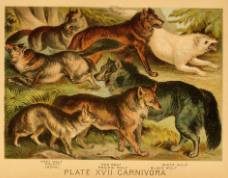Heritage Edition – Holiday Traditions Around the World
June 8, 2022
We’ve all heard of that one man in a red suit who flies around on Christmas Eve night and delivers presents to every boy and girl around the globe. Well, that’s our tradition. Traditions are in place everywhere you go. Some are fairly well known, but some make you feel like you’ve been living under a rock when you finally hear about them. Each tradition is unique to its area and culture, even the ones you’ve made with your family when you were “yay high.” Learning about each one is very entertaining, and might even spark some ideas for new ones.
Germany, Austria, and Hungary share a wild tradition that might be common knowledge by now. “Krampus” is a Christmas tale about a sort of monster who is portrayed as the complete opposite of Santa Claus. This beast-like character punishes children on the “naughty list” by kidnapping them. People who celebrate this tradition dress up as Krampus towards the beginning of December to wander the streets and scare unsuspecting children.
Mexico has an exceptionally different Christmas tradition compared to both Santa and Krampus (“11 Wacky Holiday Traditions Around The World”). It takes place on December 23, and is entitled “La Noche de Rábanos,” which translates to “The Night of the Radishes.” On this night merchants and artisans carve radishes to make a display of the nativity scene, which people buy as Christmas centerpieces. A prize goes to whoever creates the best design.
A majority of the citizens in Japan don’t have what we consider to be the average ham and mashed potatoes with gravy for their Christmas dinner. Instead, they feast on Kentucky Fried Chicken. KFC started this tradition as a marketing stunt called “Kurisumasu ni wa Kentakkii,” which translates to “Kentucky for Christmas.” This became a tradition to substitute for the lack of Christmas traditions in Japan due to the fact that the percentage of Japanese people who identify as Christian is so small.
Norway has somewhat of a superstitious tradition: according to Norwegian beliefs, witches supposedly roam the sky on the night of Christmas Eve. Everyone knows what a witch’s main source of transportation is, so to prevent the annual witch invasion, Norwegians hide their broomsticks. People will also occasionally shoot a gunshot into the air to scare the witches away.
Norwegians aren’t the only ones who associate witches with Christmas. Italians have their own take on Santa Claus, and they’ve named her La Befana. Her story begins with the three Magi on their journey to visit the baby Jesus. In the story, they come across the old witch, La Befana’s house, and ask for directions. When they invited her to join them on their quest, she politely refused, saying there was too much housework to be done. She quickly changed her mind after they left and searched for them, but had no luck. Legend has it that on the night of January 5th, the night that marks the eve of the Magis’ meeting with the baby Jesus, La Befana delivers toys and gifts to children. However, instead of milk and cookies, a plate of sausage and broccoli and a glass of wine are left out for the witch.
As you can see, traditions exist in every corner of the world. Some may not be as well known as Santa Claus, but Christmas definitely wouldn’t be the same without them. Tradition is just as important to other countries as it is to ours, and as it is to each individual who comes up with their own ways to celebrate. Tradition is in everything we do, whether we know it or not. Our traditions are what make us unique, and what sets us apart from each other.










































































































































